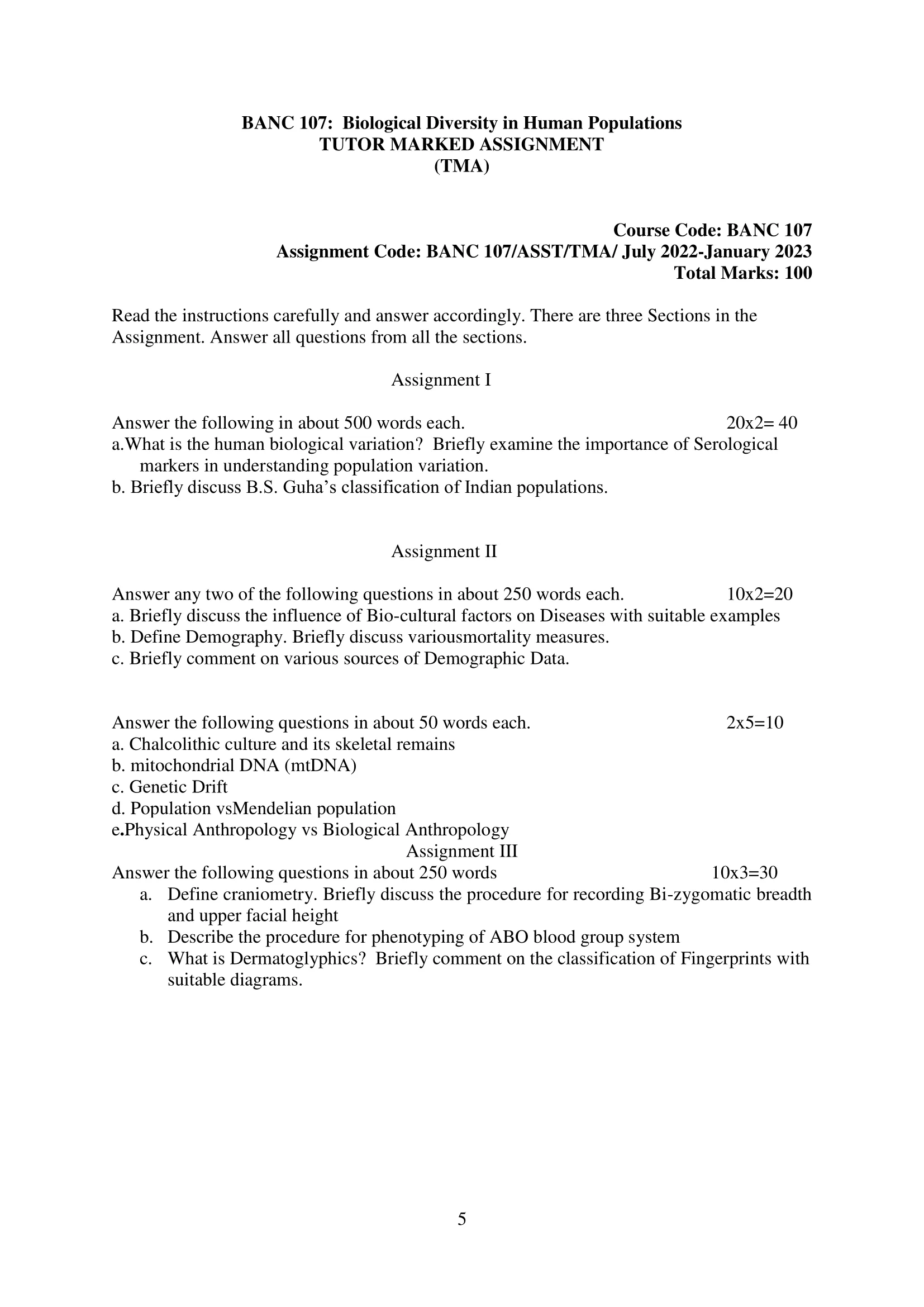
| Title | BANC-107: IGNOU BAG Solved Assignment 2022-2023 |
| University | IGNOU |
| Degree | Bachelor Degree Programme |
| Course Code | BANC-107 |
| Course Name | BIOLOGICAL DIVERSITY IN HUMAN POPULATIONS |
| Programme Name | Bachelor of Arts (General) |
| Programme Code | BAG |
| Total Marks | 100 |
| Year | 2022-2023 |
| Language | English |
| Assignment Code | BANC 107/ASST/TMA/ July 2022-January 2023 |
| Last Date for Submission of Assignment: | For June Examination: 31st April For December Examination: 30th September |

Assignment I
Answer the following in about 500 words each. 20×2= 40
a.What is the human biological variation? Briefly examine the importance of Serological markers in understanding population variation.
Ans: Human biological variation refers to differences in physical and genetic characteristics among individuals within a population. These differences can be a result of both genetic and environmental factors and can affect various aspects of human biology including physical appearance, anatomy, metabolism, and susceptibility to disease.
Serological markers are substances that can be detected in an individual’s blood and are used to study biological variation among populations. These markers include proteins, enzymes, hormones, and antibodies that are specific to an individual or population.
The importance of serological markers in understanding population variation lies in their ability to provide insight into an individual’s ancestry, migration patterns, and genetic relationships with other populations. For example, the presence or absence of certain serological markers in an individual’s blood can be used to trace their ancestry and determine whether they are of African, European, Asian, or Native American descent. This information can be used to reconstruct the migration patterns of populations and to study the genetic relationships between different groups.
Serological markers can also provide important information about the health and disease susceptibility of individuals and populations. For example, the presence of certain markers can indicate an increased risk for certain diseases, such as cardiovascular disease or certain types of cancer. This information can be used to develop targeted preventative measures and to improve diagnosis and treatment of diseases.
Additionally, serological markers can be used in forensic science to identify individuals or to link them to specific crimes. For example, the presence of a specific serological marker in a crime scene sample can indicate the presence of a particular individual at the scene and can provide important evidence in criminal investigations.
b. Briefly discuss B.S. Guha’s classification of Indian populations.
Ans: B.S. Guha was an Indian physical anthropologist who made significant contributions to the study of human biological variation in India. One of his most notable contributions was the classification of Indian populations into three broad categories: the Australoid, Mongoloid, and the Caucasoid.
The Australoid population is characterized by dark skin, curly hair, and broad noses and is considered to be the original inhabitants of India. This population is found primarily in the tribal areas of central and southern India.
The Mongoloid population is characterized by light skin, straight hair, and narrow noses and is considered to be of East Asian origin. This population is found primarily in the northeastern states of India and is thought to have migrated to India from Southeast Asia.
The Caucasoid population is characterized by intermediate skin color, wavy hair, and intermediate nose shapes and is considered to be of Indo-European origin. This population is found primarily in northern India and is thought to have migrated to India from the northwest during the Indo-European invasions.
B.S. Guha’s classification of Indian populations was one of the first attempts to categorize the diverse populations of India based on physical characteristics and was an important contribution to the field of physical anthropology. However, it should be noted that this classification is based on crude physical measurements and has been criticized for oversimplifying the complex genetic relationships among Indian populations.
Assignment II
Answer any two of the following questions in about 250 words each. 10×2=20
a. Briefly discuss the influence of Bio-cultural factors on Diseases with suitable examples
Ans: Influence of Bio-cultural factors on Diseases:
Bio-cultural factors refer to the interplay between biological and cultural factors that influence human health and disease. These factors include genetics, behavior, lifestyle, cultural beliefs, and environmental factors.
For example, nutrition is a bio-cultural factor that influences health. In certain cultures, certain foods and eating habits are valued, which can lead to a higher risk of certain diseases. For instance, in some cultures, a high-fat diet is a traditional food choice and may increase the risk of heart disease.
Another example of the influence of bio-cultural factors is the relationship between stress and disease. Chronic stress has been linked to several health problems, including cardiovascular disease
b. Define Demography. Briefly discuss variousmortality measures.
Ans: Demography:
Demography is the scientific study of the characteristics of human populations, such as size, growth, age structure, and distribution. Demographers are interested in understanding how populations change over time, including factors that influence changes in population size and composition, such as birth and death rates, migration, and health status.
b. Mortality Measures:
Mortality measures are used to quantify the number of deaths in a population and provide information about the causes and patterns of death. Some of the common mortality measures are:
- Crude Death Rate (CDR): The number of deaths in a population per 1,000 or 100,000 people. It provides a basic estimate of the overall mortality level in a population.
- Age-Specific Death Rate (ASDR): The number of deaths in a specific age group per 1,000 or 100,000 people in the same age group. It provides information about the mortality risk of a specific age group.
- Infant Mortality Rate (IMR): The number of deaths of children under one year of age per 1,000 live births. It provides information about the health and wellbeing of mothers and their newborns.
- Life Expectancy at Birth: The average number of years a newborn can expect to live, given current mortality conditions. It provides information about the overall health status of a population.
- Cause-Specific Death Rate: The number of deaths due to a specific cause per 1,000 or 100,000 people. It provides information about the leading causes of death in a population and the impact of specific health interventions.
c. Briefly comment on various sources of Demographic Data.
Ans: Sources of Demographic Data:
Demographic data is collected and analyzed from various sources, including:
- Census: A census is a comprehensive count of the population, which provides data on the size, age structure, and geographical distribution of a population. It is usually conducted every 10 years and provides the most comprehensive source of demographic data.
- Vital Statistics: Vital statistics are records of births, deaths, and marriages, which provide information on fertility, mortality, and migration patterns.
- Surveys: Surveys are used to collect data on specific topics, such as health, education, and employment, which can provide information on the demographic characteristics of a population.
- Administrative Records: Administrative records, such as birth and death certificates, hospital records, and tax records, provide information on the demographic and socio-economic characteristics of a population.
- Health Records: Health records, such as electronic health records and claims data, provide information on the health status and health care utilization of a population.
- Social Media: Social media platforms, such as Facebook and Twitter, provide data on user demographics, which can be used to study the online behavior and preferences of a population.
These sources of demographic data can provide valuable information for policymakers, planners, and researchers, helping to inform decisions about resource allocation, planning, and policy development.
Answer the following questions in about 50 words each. 2×5=10
a. Chalcolithic culture and its skeletal remains
Ans: The Chalcolithic culture, also known as the Copper Age, was a prehistoric period characterized by the use of copper and stone tools. It was a time of transition between the Neolithic and Bronze Ages and lasted from about 4000 to 2500 BCE. The skeletal remains from the Chalcolithic period provide important information about the physical characteristics, health, and lifestyle of people from this time period. These remains offer insights into the evolution of human biology and the development of human civilizations.
b. mitochondrial DNA (mtDNA)
Ans: Mitochondrial DNA (mtDNA) is a type of DNA located in the mitochondria of cells, which are the energy-producing structures in the body. Unlike nuclear DNA, which is inherited from both parents, mtDNA is passed down from the mother only. This makes mtDNA a valuable tool for tracing maternal ancestry and for studying the evolutionary relationships between populations. The mtDNA genome is relatively small compared to the nuclear genome and has a high mutation rate, making it useful for population genetics studies and for forensic analysis.
c. Genetic Drift
Ans: Genetic drift is a process in population genetics that refers to random fluctuations in the frequency of alleles (versions of a gene) in a population. This can lead to changes in the gene pool of a population over time, even in the absence of natural selection or migration. Genetic drift is more pronounced in small populations compared to larger populations, where the effects of random events are diluted. Over time, genetic drift can result in the loss of genetic variation within a population and can play a role in the divergence of populations and the evolution of new species. Genetic drift is an important mechanism of evolution, but it operates in conjunction with other processes such as mutation, selection, and migration.
d. Population vsMendelian population
Ans: A population is a group of individuals of a species that live in a particular geographic area and can interbreed with one another. A population can be defined by its physical, biological, or genetic characteristics.
A Mendelian population is a population in which the inheritance of traits follows the laws of Gregor Mendel, the father of modern genetics. In a Mendelian population, the inheritance of traits is determined by genes that follow simple patterns of dominant and recessive inheritance. This type of population is often used in laboratory experiments to study the genetics of traits and to understand the underlying mechanisms of inheritance.
In contrast, real-world populations are often much more complex and may exhibit patterns of inheritance that deviate from simple Mendelian inheritance. For example, many traits are influenced by multiple genes, environmental factors, or gene-environment interactions. Understanding the complexity of inheritance in real-world populations is an important area of research in population genetics.
e. Physical Anthropology vs Biological Anthropology
Ans: Physical anthropology and biological anthropology are subfields of anthropology that study the biology and evolution of humans.
Physical anthropology focuses on the study of human anatomy, physiology, and physical variation. This field examines the physical and biological characteristics of humans, including anatomy, genetics, and evolution. Physical anthropologists use data from fossils, living populations, and other sources to understand the biological and cultural evolution of humans.
Biological anthropology, on the other hand, focuses on the evolutionary history of humans and their primate relatives. This field studies the biological and cultural processes that have shaped the evolution of humans, including natural selection, genetic drift, and migration. Biological anthropologists use data from molecular biology, genetics, and other sources to understand the relationships between populations and to reconstruct the evolutionary history of humans.
Assignment III
Answer the following questions in about 250 words. 10×3=30
a. Define craniometry. Briefly discuss the procedure for recording Bi-zygomatic breadth and upper facial height.
Ans. Craniometry:
Craniometry is the scientific study of the measurement of the human skull, including the length, width, and height of the cranial bones. Craniometry has been used in various fields, including physical anthropology, forensic science, and archaeology, to study the variability of human cranial morphology and infer information about ancestry, migration, and population structure.
b. Procedure for recording Bi-zygomatic breadth and Upper Facial Height:
Bi-zygomatic breadth is a measure of the width of the skull, specifically the distance between the two zygomatic arches (cheekbones). To measure bi-zygomatic breadth, a caliper is used to measure the distance between two points on the zygomatic arches.
Upper facial height is a measure of the height of the skull from the upper dental arch to the top of the skull. To measure upper facial height, a caliper is used to measure the distance between two points on the skull, one on the upper dental arch and the other on the highest point of the skull.
Both bi-zygomatic breadth and upper facial height are important measurements in craniometry and are used in combination with other cranial measurements to study human variation and evolution. These measurements are typically taken with a caliper, and the procedure must be standardized and consistent to ensure accurate results.
b. Describe the procedure for phenotyping of ABO blood group system.
Ans. Procedure for Phenotyping of ABO Blood Group System:
The ABO blood group system is based on the presence or absence of specific antigens (carbohydrates) on the surface of red blood cells. There are four main blood types in the ABO system: A, B, AB, and O.
The procedure for phenotyping the ABO blood group system involves the following steps:
- Blood Sample Collection: A small blood sample is collected from the individual and placed in a tube or dish.
- Antigen Testing: The blood sample is mixed with specific antibodies (anti-A and anti-B) to determine the presence or absence of A or B antigens on the surface of red blood cells. If the red blood cells agglutinate (clump together), it indicates the presence of the corresponding antigen.
- Interpretation of Results: Based on the results of the antigen testing, the individual’s blood type is determined. For example, if the red blood cells do not agglutinate with either anti-A or anti-B, the individual is type O. If the red blood cells agglutinate with anti-A but not with anti-B, the individual is type A, and so on.
- Confirmation Testing: To confirm the results of the antigen testing, the blood sample is mixed with additional antibodies (anti-A,B) to determine if the individual has both A and B antigens (type AB) or if they are secretors (secrete antigens in bodily fluids) or non-secretors.
This procedure is performed in a laboratory setting and requires specialized equipment and trained personnel to ensure accurate and reliable results. The phenotyping of the ABO blood group system is important for blood transfusion and transplantation, as compatibility between the donor and recipient blood types is critical for successful outcomes.
c. What is Dermatoglyphics? Briefly comment on the classification of Fingerprints with
suitable diagrams.
Ans. Dermatoglyphics:
Dermatoglyphics is the study of the patterns of ridges and furrows on the skin of the fingers, palms, and soles. These patterns, known as fingerprints, are unique to each individual and are used for identification purposes in various fields, including forensic science, medicine, and anthropology.
Classification of Fingerprints:
Fingerprints are classified into three main types: arches, loops, and whorls. These types are based on the general pattern of ridge flow, the number of deltas (points where ridges enter or exit the fingerprint), and the overall shape of the pattern.
- Arches: Arches are the simplest type of fingerprint, characterized by ridges that enter one side of the fingerprint, flow across the center, and exit on the other side. There are two main types of arches: plain and tented.
- Loops: Loops are the most common type of fingerprint, characterized by ridges that enter one side of the fingerprint, make a curve, and exit on the same side. There are two main types of loops: radial and ulnar.
- Whorls: Whorls are characterized by ridges that form a circular pattern with at least two deltas. There are various subtypes of whorls, including central pocket whorls, double loop whorls, and accidental whorls.
These classifications are used by forensic examiners and other professionals to compare and identify fingerprints. In addition to the general pattern, other features, such as ridge count, ridge shape, and ridge thickness, are also used for fingerprint analysis.
How to Download BANC-107 Solved Assignment?
You can download it from the www.edukar.in, they have a big database for all the IGNOU solved assignments.
Is the BANC-107 Solved Assignment Free?
Yes this is absolutely free to download the solved assignment from www.edukar.in
What is the last submission date for BANC-107 Solved Assignment?
For June Examination: 31st April, For December Examination: 30th October
